An Investigation Approach on the Sequestration of Divalent Metal Ions Employing Animal Waste
N. S. Gayathri, N. Muthulakshmi Andal and J. Anuradha
Department of Chemistry, PSGR Krishnammal College for Women, Coimbatore, India.
Corresponding Author E-mail: muthulakshmiandal@psgrkc.ac.in
DOI : http://dx.doi.org/10.13005/ojc/330342
The current investigation deals with utilizing Treated Goat Hoof (TGH), a no cost material derived from butcher shop for the removal of Pb(II) and Cd(II) ions from aqueous media. FTIR / SEM analyses are carried out for the functional groups identification and describe the surface morphology of the chosen material respectively. Batch studies are experimented under varied operating factors viz., particle size, dosage, initial concentration, contact time and pH of the medium to assess the sorptive nature of the chosen material. Verification of the experimental data reveal the optimized conditions for the uptake of Pb(II) and Cd(II) by TGH. Langmuir model registered the best linearity amongst the isothermal plots derived for Langmuir, Freundlich and Tempkin models. Experimental results of both the systems: Pb(II) – TGH and Cd(II)- TGH are subjected to Statistical tool analyses using SPSS 20 software for significance and correlation assessment.
KEYWORDS:goat hoof; isotherms; optimization; statistics
Download this article as:| Copy the following to cite this article: Gayathri N. S, Andal N. M, Anuradha J. An Investigation Approach on the Sequestration of Divalent Metal Ions Employing Animal Waste. Orient J Chem 2017;33(3). |
| Copy the following to cite this URL: Gayathri N. S, Andal N. M, Anuradha J. An Investigation Approach on the Sequestration of Divalent Metal Ions Employing Animal Waste. Orient J Chem 2017;33(3). Available from: http://www.orientjchem.org/?p=33586 |
Introduction Water is essential for the very existence of life. Rapid industrialization is the major cause for heavy metal laden discharges into aqueous streams which are declared as toxic pollutants beyond the tolerance level.1 The chronic toxicity of heavy metals is due to the property that most of it salts are soluble in water.2 Environmental concerns have motivated many methods for heavy metal removal. Most commonly employed methods include chemical precipitation, ion exchange, adsorption, electrocoagulation, membrane filtration and reverse osmosis. These techniques however, have their own disadvantages such as incomplete metal removal, high reagent/ energy requirements, generation of toxic sludge and setting up of the experimental scale.3 Adsorption method is found to be more effective in sequestering heavy metal ions from aqueous solutions4 and wastewaters.5 Goat Hoof, a litter pollutant is employed in the present study where reports have not been found elsewhere in literature using this material for the heavy metal removal. The employment of Lead and cadmium ions in varied industries located in Coimbatore such as paper/ pulp6, electroplating, metal finishing and batteries7 have been the reason for has led to the basis for the choice of these metals to study. Materials and Methods Adsorbent Preparation Goat Hoof (GH) were collected in bulk, from the butcher shops located at market places in Coimbatore, washed well with distilled water broken to smaller pieces, sun dried for a week, soaked in 0.2N Sodium Hydroxide for 3 hours and the pH was adjusted to 9. The Treated Goat Hoof (TGH) were then dried, pulverized in a laboratory blender, sieved into different particle sizes viz., 22 BSS (0.71 mm), 36 BSS (0.42 mm), 52 BSS (0.30 mm), 72 BSS (0.21 mm) and 85 BSS (0.18 mm) using standard Scientific Test Molecular Sieves. The pictorial representations of the purchased, sieved Goat Hoof (0.18 mm) are shown in fig 1a & 1b and the microscopic view of 0.18 mm size of TGH is depicted in fig 1c.
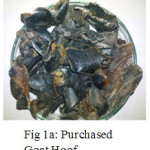 |
Figure 1a: Purchased Goat |
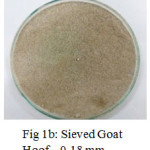 |
Figure 1b: Sieved Goat Hoof – 0.18 mm |
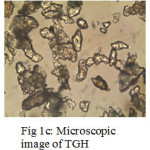 |
Figure 1c: Microscopic image of TGH |
Adsorbate Solution Stock solutions with a concentration of 1000 mg/L of Pb(II) and Cd(II) were prepared using Lead Nitrate and Cadmium Acetate (AR Grade, MERCK) salts respectively. All working standard solutions of various concentrations were prepared by appropriate dilutions of the stock solution. Batch Equilibration Experiments Experiments of Pb(II) and Cd(II) systems using TGH were carried out in order to assess its sorption efficiency, through the role of variable parameters viz., particle sizes (0.18 mm – 0.71 mm) and dosages (50 mg- 250 mg: 50 mg) of TGH, initial concentrations (50, 100, 150, 200 and 250 mg/L) of the divalent solutions, agitation time between the sorbate and sorbent species (5 – 30 min: 5 min) and pH of the medium (3, 5, 7, 9 and 11). 50 ml of the predetermined concentrations of Pb(II) and Cd(II) were taken in 100 ml Erlenmeyer flasks and appropriate doses of TGH with specified sizes (pH of sorbent maintained at 9 after various trails) were added and agitated in a Rotary Shaker (KEMI) at 120 rpm/ minute for preset time intervals, the temperature being 30°C. The pH measurements of the sorbent, unloaded, loaded samples were recorded using LABTRONICS pH meter. The initial and residual metal ion concentrations of the chosen divalent ions were analyzed using SHIMADZU (AA 6200) Atomic Absorption Spectrophotometer (AAS) operated with air acetylene flame. The concentrations of the unknown samples were observed as a linear range of the references with dilutions to appropriate concentrations. The percentage adsorption of metal ions was estimated using the following equation.8 % adsorption = (Ci– Ce )/ Ci X 100 (1) The amount of sorbate species adsorbed (q) were calculated using the following mass balance equation q = V(Ci– Ce )/ W (2) where, V is the volume of the solution (L), m is the mass of the adsorbent (g), Ci and Ce are the initial and equilibrium metal concentrations (mg/L) respectively. Statistical Analysis The Batch Equilibration results were systematically analyzed using SPSS 20 (IBM SPSS Statistics) Software. Studies on Descriptive, paired T test and analysis of variance (ANOVA) were calculated to validate the experimental data for the effects of optimized particle size, dosage, pH, initial concentration and contact time during the adsorption process. These tests were used to compare the relationship and variability of the parametric data where the significance is based on 95% confidence level. Results and Discussion Physicochemical Characteristics – Tgh Table 1 lists the physicochemical characteristics of TGH, as compared with that of other studied sorbents. The specific gravity was observed to lie between 1.3 and 2.0, implying the inactiveness of the organic material during sorption process. The bulk density value <1 is indicative of large number of pores on the TGH surface, inturn supporting the enhanced metal sorption. The porosity value (53.305) specifies the fact that the chosen material is mesoporous in nature, defining it to possess excellent sorption capacity against other compared values. The ash content value of TGH (4.1805) indicates the larger percent of carbon content and least presence of inorganic matter. Moisture content (< 5 %) indicates of favorable adsorption. The lower ash and moisture content values promote the advantageous sorptive nature of the TGH which is observed to be greater than in the corresponding values (table 1). Therefore, the trapping ability of TGH may be highly dependent on its chemical nature and internal pore structure. Table 1: Characteristics Comparison with other sorbents
| Factors | Goat Hoof | Prosopis Spicigera9 | Feronia limonia Shell10 | Ricinus communisSeed Shell11 |
| pH | 8.24 | 6.9 | 6 | 7.7 |
| Bulk density (g/L) | 0.61 | 0.3915 | 0.757 | 0.4384 |
| Specific gravity | 1.304 | 1.48 | 1.49 | 1.6367 |
| Porosity | 53.3052 | 70 | 49.19 | 70 |
| Moisture (%) | 2.24 | 8.5 | 17.2 | 3 |
| Ash content (%) | 4.1805 | 3.86 | 10.16 | 7.52 |
FT-IR Analysis The possibilities of functional groups on TGH to be involved in the biosorption of Pb(II) and Cd(II) ions were determined using FT-IR Spectroscopic studies (fig 2). The major functional groups observed on the raw GH fig 2(a) with their corresponding peaks are O-H (3278.16 cm-1), C-H (2901.06 cm-1), C=O (1632.81 cm-1), S-H (2306.96 cm-1), C-O (1232.57 cm-1and 1034.85 cm-1) and amino group (1524.79 cm-1and 1389.77 cm-1). The OH band at 3278.16 cm-1 is found to disappear after treatment, indicating the deprotonation, followed by the probable formation of metal oxygen bond during sorption. A shift in the position of few functional groups is noticed in the unloaded and metal laden TGH supporting the involvement of these groups during sorption process.
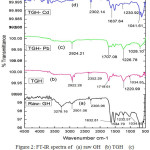 |
Figure 2: FT-IR spectra of (a) raw GH (b) TGH (c) Pb(II) – TGH (d) Cd(II) – TGH Click here to View figure |
Surface Morphology The SEM images of the unloaded and metal laden TGH depicted in figs 3a, 3b & 3c. Fig 3a registers a high porous morphology and a coarse surface texture with different shapes and sizes. The due morphological changes as obvious from fig 3b & 3c suggest that effective sorption of Pb(II) and Cd(II) had occurred on the sorbent’s surface.
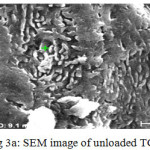 |
Figure 3a: SEM image of unloaded TGH Click here to View figure |
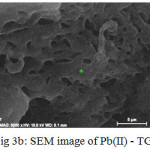 |
Figure 3b: SEM image of Pb(II) – TGH Click here to View figure |
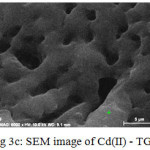 |
Figure 3c: SEM image of Cd(II) – TGH |
Effect of Particle Size Particle size plays a vital role in the determining the sequestration capacity of TGH for the uptake of Pb(II) and Cd(II) from aqueous solutions. Both the systems registered a maximum sorption capacity (mg/g) against smallest the particle size of 0.18 mm amongst the chosen sizes (fig 4). This can be explained by the fact that relatively smaller particle size yields large surface area. According to Weber and Morris12, the breaking of larger particles tends to open tiny cracks and channels on the particle size surface of the material resulting in more accessibility towards better diffusion.
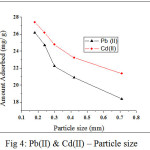 |
Figure 4: Pb(II) & Cd(II) – Particle size Click here to View figure |
Effect of pH The results pertaining to variable pH environments for the studied metal systems are represented in fig 5. Adsorption is observed to increase with pH and the maximum amount adsorbed were recorded at pH 5 & pH 7 for Pb(II) and Cd(II) ions respectively. Further increase in pH led to a decline in the adsorption curves. The reduced sorption rate at highly acidic and alkaline pH ranges may be attributed to the protonation of the sorption sites and preferential hydroxyl complex formation of the metal ion in solution respectively.13
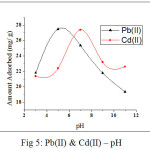 |
Figure 5: Pb(II) & Cd(II) – pH |
Effect of Adsorbent Dose Removal of metal ions were found to be less at lower doses, but exponentially increased and reached equilibrium at 200 mg (figs 6a & 6b). The increase in metal uptake against doses (50 – 200 mg : 50 mg) is due to the proportional availability of active sites for adsorption.14, 15
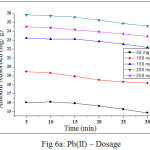 |
Figure 6a: Pb(II) – Dosage |
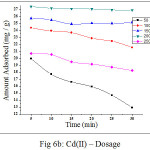 |
Figure 6b: Cd(II) – Dosage |
Effect of Initial Concentration and Contact Time The influences of initial metal ion concentration (50 – 200 mg/L: 50 mg/L) and contact time (5 – 10 mins : 5 mins) for Pb(II) – TGH and Cd(II) – TGH systems are presented in figs 7a & 7b respectively. Equilibrium was found to attain at a contact time of 5 minutes after which the systems appeared to reach a saturation point. This is obvious from the plateau nature of the curves from 5 – 30 mins. Increase in percent removal against metal ion concentration (upto 100 mg/ L) is obvious from the figures. Further increase in initial concentration leads to the lowering of metal uptake, the reason could be reduction in ratio of sorptive surface to metal ion concentration. Henceforth, 100 mg/L was fixed as the optimum concentration for both the systems with an agitation time interval of 5 mins for their removal.
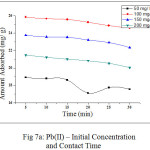 |
Figure 7a: Pb(II) – Initial Concentration and Contact Time |
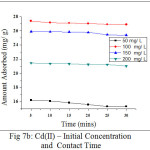 |
Figure 7b: Cd(II) – Initial Concentration and Contact Time Click here to View figure |
Interpretation of SPSS Based on the results and observations, conditions have been optimized for the maximum removal as: 0.18 mm Particle Size, 200 mg Dose, 5 mins Contact Time,100 mg/ L Initial Concentration for both the systems with variation in fixation of pH ranges [pH 5 for Pb(II)] and [pH 7 for Cd(II)]. The statistical criteria used to corroborate the optimized experimental data on the adsorption process of the systems are listed in table 2. Mean value, Standard deviation value, Standard error of mean value and P values were calculated with reference to the significant value of 0.05 confidence level. Paired T-test registered the significant correlation between the amounts of divalent ions adsorbed (qe mg/g) and relevant assessed parameters. The mean square and sum square values of ANOVA calculated intend to signify the deviation between the sorbed and unadsorbed species. The calculated statistical data are found to correlate well with the experimental data. The probability values calculated for the influence of operating parameters viz., particle size, initial concentration and contact time, pH are observed to be lesser than the significant value (0.05), implying of the rejection of null hypothesis for both the metal ions. But in the case of dosage, the P values are greater than the significant value (0.05), favoring the acceptability of null hypothesis. From the T- test results, a negative correlation is observed for the study of particle size and pH factors, representing an increase in the sorption, being indirectly proportional to the aforesaid factors. The positive correlation values from the calculations as far as the effects of dosage, initial concentration and contact time are concerned, indicate an increase in the amount adsorbed with an inclination of the parametric values for both the systems. Sum square and Mean square values of each factor quantifies their importance in the adsorption process where these values play a significant role in favour of the experimental evidences. Table 2: Descriptive, T- Test and ANOVA analysis of various parameters
| System | Parameter | Descriptive | Paired T-Test | ANOVA | |||||
| Mean | SD | SEM | P | Corr. | Sig. | MS | SS | ||
| Pb(II)- TGH | Particle Size | 22.47 | 3.07 | 1.37 | 0.03 | -0.94 | 0.01 | 37.77 | 9.44 |
| Dosage | 22.07 | 4.01 | 1.79 | 0.09 | 0.91 | 0.03 | 64.18 | 16.05 | |
| Initial concentration & contact time | 22.01 | 4.44 | 2.22 | 0.04 | 0.45 | 0.54 | 59.37 | 19.79 | |
| pH | 22.56 | 2.89 | 1.29 | 0.02 | -0.41 | 0.48 | 33.54 | 8.38 | |
| Cd(II)- TGH | Particle Size | 24.57 | 2.38 | 1.06 | 0.04 | -0.95 | 0.01 | 22.74 | 5.68 |
| Dosage | 23.60 | 3.22 | 1.44 | 0.06 | 0.22 | 0.72 | 41.53 | 10.38 | |
| Initial concentration & contact time | 22.74 | 5.02 | 2.51 | 0.04 | 0.36 | 0.63 | 75.75 | 25.25 | |
| pH | 23.38 | 2.33 | 1.04 | 0.05 | -0.22 | 0.71 | 21.77 | 5.44 | |
SD – Standard Deviation SEM – Standard Error of Mean Corr. – Correlation Sig. – Significance MS – Mean Square SS – Sum Square Adsorption Isotherm Adsorption isotherms indicate the distribution of molecules between the liquid phase and solid phase when the adsorption process reaches an equilibrium state.17 The present study focuses on three isothermal studies viz., Langmuir, Freundlich and Tempkin, where isothermal constant values are tabulated in table 3. Langmuir Isotherm Langmuir Isotherm equation can be written as Adsorption Isotherm Adsorption isotherms indicate the distribution of molecules between the liquid phase and solid phase when the adsorption process reaches an equilibrium state.17 The present study focuses on three isothermal studies viz., Langmuir, Freundlich and Tempkin, where isothermal constant values are tabulated in table 3. Langmuir Isotherm Langmuir Isotherm equation can be written as Ce / Qe = Ce /Qm + 1 / bQm (3) The Langmuir constants Qm and b of Pb(II) – TGH and Cd(II) – TGH were calculated from the linear slopes 1/Qm and intercepts 1/bQm from the figs 8a and 8b, is listed in table 3. Maximum Qm values of Pb(II)– TGH and Cd(II)- TGH systems being 29.7619 mg/ g and 29.9401 mg/g respectively, indicate the physical monolayer adsorption. The essential characteristics of the Langmuir equation can be expressed in terms of a dimensionless separation factor (RL). The RL values imply an unfavourable adsorption (RL > 1), Linear (RL =1), favourable (0<RL<1), or irreversible (RL=0). RL values for the current study lying between 0 and 1 declare favourable adsorption under specified conditions.18 The correlation coefficients (R2) ranging as 0.9994 and 0.9997 for Pb(II) and Cd(II) ions with best linear fit of the plot favour Langmuir isotherm.
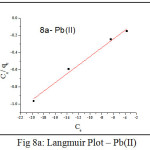 |
Figure 8a: Langmuir Plot – Pb(II)
|
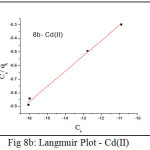 |
Figure 8b: Langmuir Plot – Cd(II) Click here to View figure |
Freundlich Isotherm Linear plots of log Ce Vs qe (figs 9a and 9b) based on the Freundlich equation : (log qe = log Kf + 1/n log Ce), indicate that the systems obey this isotherm model also. However, a comparison amongst the isothermal constants reveals the better fit of Langmuir model.This is further supported by the adsorption intensity values (b > 1/n).
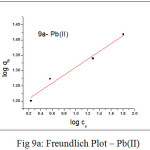 |
Figure 9a: Freundlich Plot – Pb(II) |
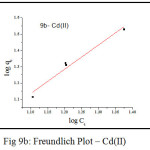 |
Figure 9b: Freundlich Plot – Cd(II) Click here to View figure |
Tempkin Isotherm Tempkin isothermal equation (qe = Bln A + Bln Ce) contains a factor that explicitly takes into account adsorbent-adsorbate interactions. The constant A and B are related to the heat of sorption and maximum binding energy respectively (figs 10a & 10b). The values of correlation coefficients and constants fairly fitted to the Temkin model and the results were similar to those of M. Sujatha et al.19
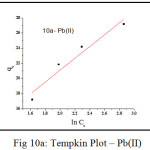 |
Figure 10a: Tempkin Plot – Pb(II) |
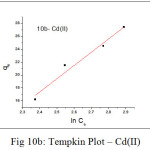 |
Figure 10b: Tempkin Plot – Cd(II) Click here to View figure |
Table 3: Calculated isothermal constants for Pb(II) and Cd(II) on TGH
| System | Langmuir | Freundlich | Tempkin | |||||||
| Qm | b | R2 | RL | Kf | 1/n | R2 | B | A | R2 | |
| Pb(II)- TGH | 29.76 | 1.17 | 0.99 | 0.016 | 24.53 | 0.032 | 0.96 | 10.88 | 9.57 | 0.95 |
| Cd(II)–TGH | 29.94 | 1.06 | 0.98 | 0.010 | 21.67 | 0.031 | 0.95 | 10.01 | 11.45 | 0.94 |
Conclusion Goat hoof, an animal waste were collected from local butchers were employed for the removal of toxic Pb(II) and Cd(II) ions from aqueous solutions, with seldom research reported elsewhere. The collected was subjected to chemical treatment and the sample was tested for its suitability to remove the chosen divalent ions by Batch Equilibration method. This was ensured through the verification of operational factors and further confirmed by characteristics (FTIR & SEM) and Statistical analyses (Descriptive, T-Test & ANOVA). Isothermal studies proved the better linear fit in of Langmiur plot, thereby supporting monolayer adsorption. Based on these observations, it is concluded that Treated Goat Hoof serves the betterment of the societal setup as a part of cleaning up the litter and trapping the toxic ions with 98 %. Reference
- Mehmet Emin Argun; Sukru Dursun; Mustafa Karatas. Desal. 2008, 249, 519–527.
CrossRef - Dhiraj Sud; Garima Mahajan; Kaur, M. P. Biores Technol. 2008, 99, 6017–6027.
CrossRef - Ahalya, N.; Kanamadiand, R. D.; Ramachandra, T.V. J. Environ. Biol, 2007, 28(4): 765-769.
- Boldizsar Nagy.; Carmen Mânzatu; Szende Tonk.; and Cornelia Majdik. J. Environ. & Biotech. Res. 2016, 2(1), 27-36.
- Ahmaruzzaman, M. Adv. Colloid Interface Sci. 2011, 166, 36–59.
CrossRef - Verma, V. K.; Gupta, R. K.; and Rai, J. P. N. J. Sci & Indus Res, 2005, 64, 778- 781.
- Wan Ngah, W. S.; Hanafiah, M. A. K. M. Biores. Technol. 2008, 99, 3935–3948.
CrossRef - Venkateswaran, V.; Kalaamani, P.; and Karpagam, N. Chem. Sci. Trans. 2015, 4(2), 347-354.
- Karthikeyan, S.; Sivakumar, P. J. Environ. & Nanotech. 2012, 1(1): 05-12.
- Thamilarasu, P.; and Karunakaran, K. Can. J. Chem. Eng. 2012, 9999, 1–10.
- Javier Bayo, Chem. Eng. J. 2012, 191, 278– 287.
CrossRef - Karthikeyan, S.; Sivakumar, P.; and Palanisamy, P. N. E – J. Chem. 2008, 5, 409-426.
CrossRef - Nwabanne, J.T.; and Igbokwe, P.K. Int. J. Multidisplinary Sci. Eng. 2012, 3(7), 46- 52
- Leila Mahdavian. Afr. J. o. Microb. Res. 2012, 6(1), 183-189
- Jeyaseelan Aravind; Shanmugaprakash Muthusamy; Sangeetha Hubbathalai Sunderraj; Lenin Chandran; Kanmani Palanisamy. Int. J. Indus. Chem. 2010, 2(2), 72-82.
- Hossain, M. A.; Ngo, H. H.; Guo, W. S.; and Nguyen, T. V. J. Water Sustain. 2012, 2(1), 87–104.
- Ahmet Ornek; Mahmut Ozacar; Ayhan Sengil, I. Biochem. Eng J. 2007, 37, 192-200.
- Hanim Awab.; and Thanalechumi Paramalinggam. J. Fund. Sci. 2011, 7(2), 113-119.
- Sujatha, M.; Geeetha, A.; Sivakumar, P.; Palanisamy, P.N. E– J. Chem. 2008, 5(4), 742- 753.

This work is licensed under a Creative Commons Attribution 4.0 International License.









